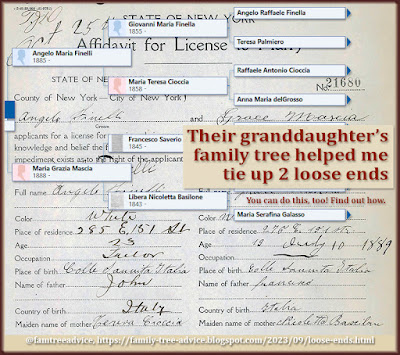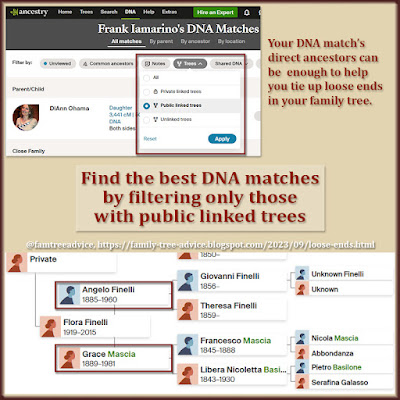As I've explained to death, I'm fitting every vital record from my hometowns into one huge family tree. (See "Why Your Half 4th Cousin Once Removed Matters.") But the vital records have limitations. In my towns, there are no civil records before 1809, deaths and marriages end in 1860, and births end in 1915. Then there's a brief hurrah from 1931–1942 with death and marriage records only.
That means I have tons of people who become a loose end. If they married from 1861–1930, and it isn't written on their birth record, I don't know who they married. I don't know what became of them.
That's where DNA matches come in. Because of my obsessive research, I've never found a DNA match who can help me get back further in my family tree. But they can bring me forward! They know who their grandparent married.
Today I'm going to seek out a DNA match who can tie up loose ends for me. I'm looking through my dad's DNA matches for anyone with a decent-sized family tree.
 |
| This simple technique can lead you to research that ties up loose ends in your family tree. |
I look at a match's direct ancestors in the tree preview Ancestry shows on the match page. Which last names do I recognize? I found a match where I recognize a few names on her maternal side. On this branch I see 4 last names I know, and they're all from the town my maiden name comes from—Colle Sannita:
- Finelli
- Mascia
- Basilone
- Galasso
I found both of this DNA match's maternal grandparents in my family tree already. But I had no way of knowing they married one another. Her grandfather Angelo is my 5C2R (5th cousin twice removed). Her grandmother Maria Grazia is my 4C3R. The combination of my 5C2R marrying my 4C3R may be making this match look like a closer relative than she is.
She's categorized in my dad's 4th–6th cousin range because they share 36cM. But those 36cM come from 4 different segments. Their longest segment is only 10cM. They may be as distant as 7th cousins. (Now that this DNA match is in my family tree, I can see she's my dad's
6th cousin. That relationship is not among the possibilities listed on
Ancestry. It's far more distant.)
Her family tree says Angelo married Maria Grazia and they had a child in New York. With that hint, I can research the couple in America for proof of their relationship. Here's what I found:
- Angelo's draft registration card confirms his birth date (I have the Italian birth record). It says his wife is Grace (an Anglicized Grazia).
- Grace's U.S. naturalization record confirms her maiden name and town of birth. Her birthday is the same as on her Italian birth record, but the year is off by one. The document lists her 5 children with their birth dates. I love when that happens. One of the kids is the DNA match's mother.
- The 1920 U.S. census shows Angelo and Grace living with their children and Angelo's parents. Angelo's birth record confirms his parents' names.
- The NYC Municipal Archives website has their 1908 marriage certificate. (How cool is it that they lived a few doors away from my grandmother?) Their parents' names are on the certificate, removing any possible remaining doubt.
It bothers me so much that the vital records for my towns have so many limitations. What became of all those 1880s babies? Who did they marry? When did they die?
Now that I've shown how a match's family tree can provide the right clues, I know I can tie up more and more loose ends.
Set Yourself Up for Success
To tie up loose ends in your family tree using your DNA matches:
- Filter your DNA match list to those with a linked public family tree. Make sure the tree has more than 10 people in it.
- Choose a match and scan their direct ancestors for familiar last names.
- Check to see if one of their people is in, or can fit into, your family tree.
 |
| Choose the best candidates among your DNA matches to find the answers that were out of your reach. |
Don't stop there. Unless your match has sources and documents in their family tree, treat their data as hints. Do the research yourself and find the proof you need. In the end, you'll know exactly how you're related to your DNA match.
But better than that, you'll start tying up those loose ends.
DiAnn, I can't recall if I asked you before, but if you would like to review Roberta Estes' book, DNA FOR NATIVE AMERICAN GENEALOGY, I would be happy to send you an examination copy.
ReplyDeleteBest wishes,
Joe Garonzik, Marketing Dir.
Genealogical.com
Hi, Joe. I don't think you have asked me before. After looking at the book online, I think it's out of my usual arena. I don't think I'm the right person to review it.
Delete